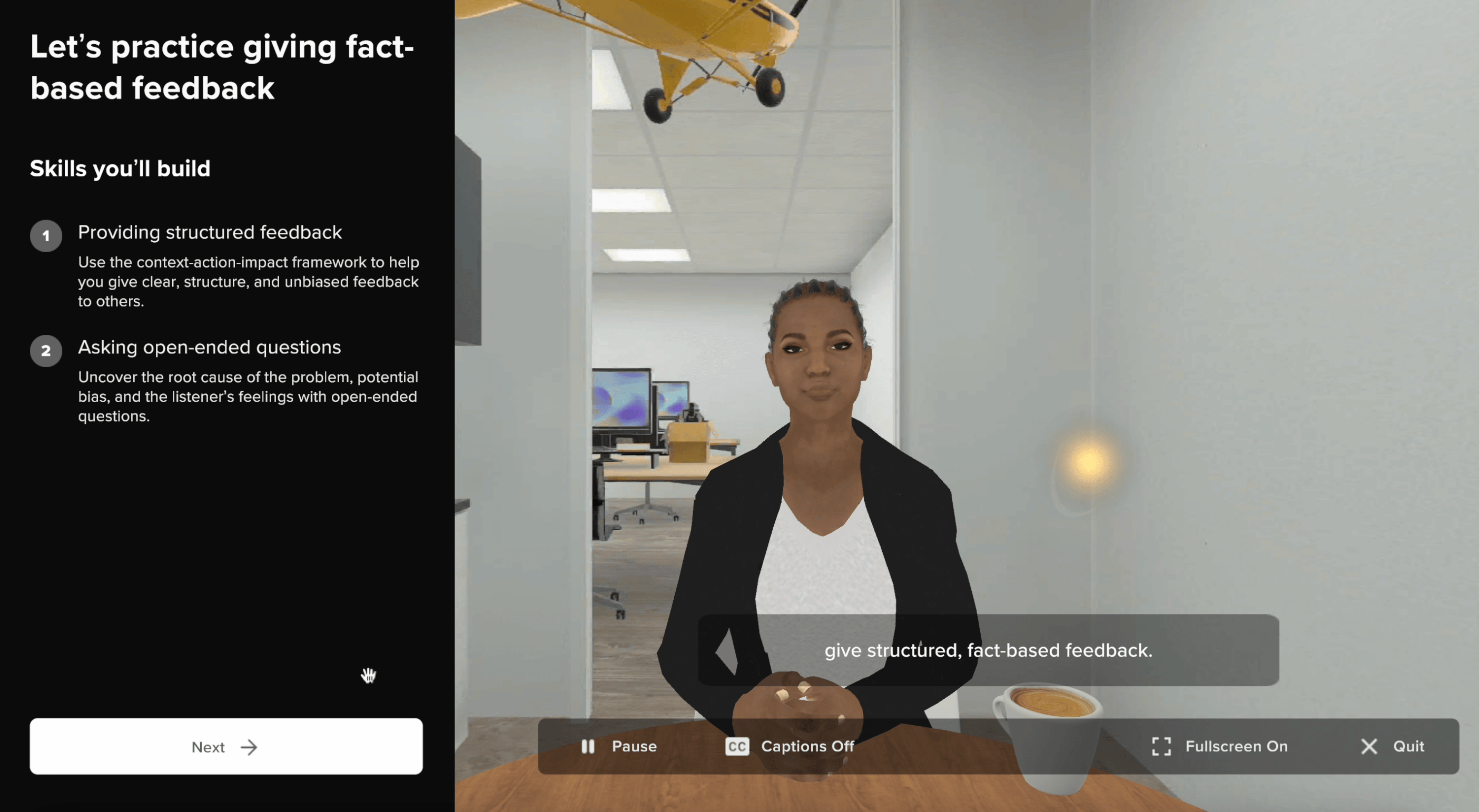- DEIJ, Learning and Development
Immersive Learning: Harnessing Technology to Create a New Empathetic Reality in the Workplace
The idea of “immersion” has long captivated the imagination of Hollywood, with protagonists in popular titles like “The Matrix” and “Jumanji” using virtual reality to explore fictional environments like dystopian computer simulations and supernatural jungles, respectively.
Since the turn of the millennium, technological advancements have brought Virtuality Reality/Mixed Reality (VR/MR) to the mainstream, with wearable goggle-like Oculus devices becoming increasingly popular among techies and gamers. Despite this widespread association with recreation and entertainment, many have also begun to realize the incredible potential of VR/MR technology to revolutionize education and skills development.
This new type of “immersive” learning is quickly growing as a solution of choice for workplaces and schools alike. It’s become much more than just a flashy new toy, with stronger indicators of success than traditional e-learning or in-person classroom training. But what exactly is immersive learning and how does it drive more tangible DEIJ learning outcomes?
What is immersive learning?
Technically speaking, immersive learning spans virtual reality (VR), mixed reality (MR), augmented reality (AR), and 360-degree video. Learners access content through a VR oculus headset, mobile device, or web browser. Regardless of entry point, immersive learning tech works similarly by leveraging the power of ‘presence’ to create a truly experiential learning environment.
What makes immersive learning deeply impactful is that learners navigate real-world experiences in a safe, simulated scenario where they can practice and learn from mistakes.
Immersive learning is a tool that helps learners translate learning into action by building the memory and muscle needed to apply learning to real-world situations; ultimately creating a feedback loop that connects learning outcomes and business goals. This approach, which capitalizes on dedicated knowledge and research about how people learn has proven results, with research showing it can increase knowledge retention by up to 75%.
While immersive learning can and should be applied to many types of skills development, it’s particularly useful for building core competencies for today’s modern workforce, such as empathy and inclusive leadership. Moreover, immersive learning is ideally suited to Diversity, Equity, Inclusion and Justice (DEIJ) training, about which much ink has been spilled, but unfortunately rarely moves the needle as it should.
By harnessing immersive learning technology, there is immense potential in driving the self-awareness and understanding needed to propel tangible results for DEIJ. There are four key reasons why this is the case.
1. Empathy: Using VR to Build it in the Workplace
At its most basic, immersive learning allows learners to view and experience the world through a different perspective. They can experience the scenario-based environment from many sensory angles, which can blur the line between simulation and reality. This is where ‘presence’ comes in.
It means that business leaders and DEIJ professionals can drive greater empathy and understanding across folks with different lived experiences, without burdening colleagues from underrepresented groups to share their personal experiences for the sake of educating others. These learners can then better understand the importance of — and place a greater emphasis on — respecting different perspectives. In turn, empathy lays a sturdy foundation that leads to stronger, more effective teams where all members are valued and appreciated.
There is a proven positive correlation between VR/MR technology and empathy, notably supported by a 2018 Stanford University experiment, where researchers found that those who participated in a virtual reality experience detailing what it’s like to be homeless made them more likely to support affordable housing than other participants in the study.
In the workplace, once employees are able to feel themselves in the perspectives of colleagues from backgrounds different than their own, other aspects of DEIJ training fall into place. Lessons are more easily translatable to real-world situations, and learners are able to approach those moments with greater confidence in how to act equitably and inclusively.
2. Unconscious Bias Training: Seeing it “First-Hand”
A key topic addressed in nearly all types of DEIJ training is unconscious bias, which can be defined as an unfair belief about a group of people that you are not aware of and that affects your behavior and decisions. Biases are not always easily identified and may happen without awareness, which is why it can be difficult for some employees to understand and identify them.
Immersive learning gives the learner the opportunity to see first-hand how unconscious bias affects employees. This form of perspective-taking can equip them with research-backed steps to overcome bias and build authentic connections.
For example, when white employees are shown how racism is experienced by their Black colleagues, or how able-bodied people are thrust into navigating the workplace as someone in a wheelchair, they gain a deeper understanding of what it feels like to be the recipients of unconscious bias. This creates an emotional connection, which is likelier to build memories and influence future behavior than more traditional types of e-learning or instructor-led training.
3. Microaggressions: Using Roleplay to Achieve Solutions
Similar to unconscious bias, microaggressions can be direct or indirect forms of discrimination against members of underrepresented groups, and are also extensively covered in DEIJ trainings.
Not only can immersive learning enable employees to recognize these microaggressions from the perspectives of colleagues from diverse backgrounds, it can also be taken from the perspectives of those complicit in or bystanders to moments of bias. Taking on these dual perspectives enables learners to workshop solutions through roleplay and real-time feedback.
Far more effective than simply listening to someone describe a microaggression, immersion puts the learner directly into the position of individuals on both sides of the incident. They can then practice navigating these tough situations through roleplay, going through the exercise — and potentially some tough conversations — as many times as necessary to feel comfortable, without fear of shame or embarrassment.
Employees have the freedom to actually learn through trial and error how their tone, word choice, and even body language can have an impact on the given situation. Then, they can feel more confident in both recognizing microaggressions in the office, as well as understanding how to navigate them and achieve solutions.
4. Ally to Advocate: How Immersive Learning Creates Cohesive Teams
As employees use immersive learning to build empathy for people of different backgrounds, identify unconscious bias, and understand how to navigate microaggressions, they also crucially create a foundation for a lifetime of allyship and advocacy.
Allyship and advocacy are closely related, but there are important differences.
Allyship denotes passive support in someone or a group in which the person has a vested interest, whereas an advocate uses their own privilege and platform to bring attention to injustice and affect change. Essentially, the line of difference is across passive support versus action.
By immersing employees in potentially fraught scenarios, they can learn how to move beyond performative allyship and understand how to actually use their own position of power and privilege to affect change.
For example, immersive learning environments may place the learner in a situation where a manager makes a discriminatory remark about a colleague. Learners then explore various scenarios about how best to speak up. This both empowers the employees and builds trust among team members, which can translate to better cohesion, retention, and efficiency in the company as a whole.
The Only Limit Is Our Own Imagination
Not long ago, the concepts of virtual reality and immersion were squarely in the domain of science fiction writers and creative auteurs who used these abstract concepts to explore far-off and imaginary realms and identities. Now, we are able to harness this incredible technology for a very real and perhaps equally ambitious purpose: to create more equitable, inclusive and empathetic workplaces.
As VR and MR technology continues to rapidly advance and research continues to show its effectiveness in building empathy and understanding, business leaders are only limited by their own imaginations in terms of how it can be harnessed to drive real, tangible results for their DEIJ initiatives.









